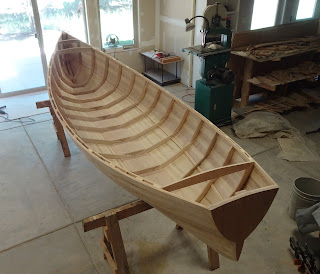Now I have a boat to look at
Eventually, I will post a complete list of offsets/dimensions for my new skiff. Beyond the numbers, there are two details that I consider important to achieving a good result. 1) The listed longitudinal location of each frame is for the side closest to the center of the hull. The reason for this is that the center is the widest point. When fairing the hull, you preserve that dimension on the center-facing frame surface and taper the other side of the frame. 2) After plotting all the listed offsets for a frame, connect the dots using a fair batten or a French curve. Do not use straight lines if you want a nice smoothly curved hull surface. Then, when actually planking the hull, create a flat landing surface for each plank as it is adapted to the hull. This will provide stable adaptation with better bonding.
I used two-inch-wide planks because that is the thickest that my saw will cut and the widest that most of my clamps will span across. Two-inch planks are difficult (or impossible) to edge-set, but more surface is covered by each plank. Narrower planks will be easier to cut and easier to edge-set when needed. Thinner stock may also be easier to obtain. If using narrow, i.e., 3/4-inch planks, the curved frame edges may not need to be modified for plank landing (the curvatures are not significant over such a short distance)
Planking completed. The hull is 13 feet, 5 inches long. The beam when completed will be 46.5 inches. Ideally, I think a more usable length would be a foot longer. This is the shortest hull I have ever built. One reason I used the shorter length was a test for planking. A longer hull will have milder curvature and planks should adapt more easily.Before planking, a commenter called this a "flat-bottomed" boat. Only the 10.5-inch-wide keel is flat (and tapers at the ends).
.









1 Comments:
Nice blog! Such a beautiful yacht design. I love all of these designs.
yacht charter dubai
Post a Comment
<< Home